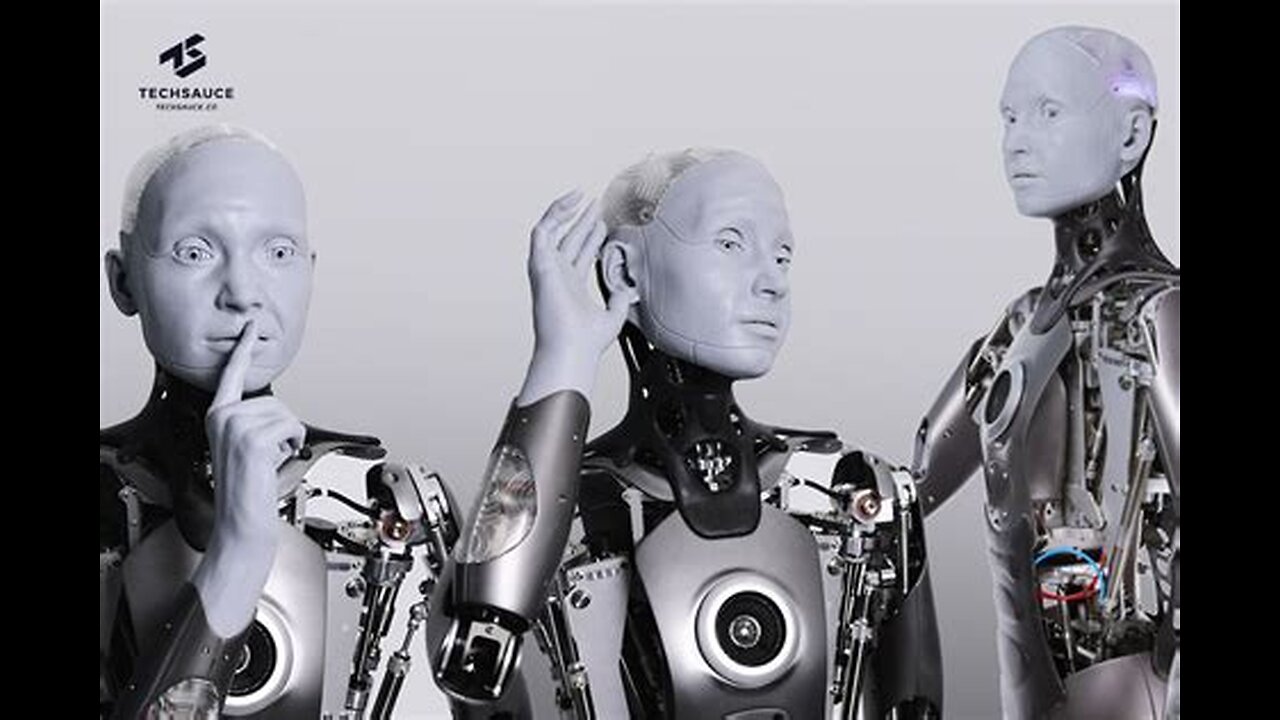Premium Only Content

A New Dawn of Mechanized Life: The Evolution, Essence, and Foresight of Robotics
From small mechanical contraptions of yesteryear to today’s adaptive, learning machines, the history of robotics is both a technical chronicle and a cultural saga. It marks humanity’s age-old quest to breathe dynamism and purpose into metal, circuitry, and code. In tracing the roots of these artificial entities, we see not merely a technological progression, but reflections of our collective ambitions, anxieties, and creativity. Below is a thoughtful exploration of robotics’ transformative journey, current tendencies, and alternative ideas for what may yet come.
⸻
1. Early Bearings: Mechanical Curiosities to Industrial Emergence
1.1 Ancient Automatons and Medieval Mechanics
Centuries before the term “robot” existed, legends spoke of artifices that mimicked life. In Ancient Greece, lore of mechanical birds or statues that “moved” enthralled philosophers and aristocrats alike—visions that danced the line between ingenuity and sorcery. By the medieval and Renaissance eras, clockwork automata, elaborate water-powered machines, and mechanical marvels adorned European courts, forming proto-models of mechanical sophistication.
Why These Artifacts Matter:
Such early contrivances signaled an enduring human fascination with bridging the inanimate and animate. Whether for worshipful displays, entertainment, or demonstration of power, these devices foreshadowed the deeper yearning to automate tasks and replicate life’s motion.
1.2 Industrial Rise: The Birth of Automated Systems
The Industrial Revolution brought harnessed steam, mass production, and newly mechanized routines:
• Assembly-Line Insights: The spread of standardized parts and conveyor-belt methods laid the conceptual groundwork for robotics. Though machines then lacked autonomy, they introduced the notion of mechanized aid for repetitive labor.
• Emergence of “Cybernetic” Thought: Enlightenment-era philosophers and engineers glimpsed the synergy of control systems and feedback loops, forecasting the possibility of machine “decision-making” decades before computing boomed.
Impact: This phase provided the infrastructure—interchangeable components, consistent power sources, nascent control theories—that would later coalesce into genuine robotics.
⸻
2. The 20th Century: Forming the Modern Robotic Identity
2.1 From Literary Coinage to Real-World Application
• Karel Čapek and the “Robot”: In 1920’s R.U.R. (Rossum’s Universal Robots), Čapek gave us “robot”—a term signifying synthetic laborers. While his robots were more bio-artifacts than mechanical constructs, the concept irreversibly shifted public imagination toward mechanical companions or workforce replacements.
• Wiener’s Cybernetics and Post-WWII: Visionaries like Norbert Wiener formalized the science of feedback loops, leading to the earliest applications of semi-autonomous machinery in factories. Suddenly, mechanical arms performing precision tasks—like welding—became feasible.
2.2 The Shift to Programmable Intelligence
• Industrial Robotics: By the late 20th century, big manufacturing discovered robotic arms guided by programmable logic controllers. They replaced humans in repetitive tasks, sowing the seeds for “lights-out” manufacturing floors.
• Emerging AI: Parallel leaps in computing gave impetus to the idea of true machine intelligence: not mere automation, but adaptive reasoning. While early experiments were rudimentary, they fueled speculation about how mechanical constructs might eventually exhibit near-human cognition or dexterity.
⸻
3. Contemporary Tapestry: Adaptive, Interconnected, and Evolving
3.1 The Rise of Deep Learning
In modern times, robotics harnesses machine learning to refine behaviors based on sensor data. Thus:
• Neural Networks for Vision: Robotic eyes now identify objects or interpret gestures with an accuracy once deemed impossible.
• Dynamic Adjustments: Beyond pre-coded motions, some robots adapt to irregular tasks (like sorting random items or assisting with frail individuals), reflecting a shift from rigidity to genuine adaptability.
3.2 Soft Robotics and Bio-Inspiration
• Fluid or Soft Materials: Borrowing morphological ideas from jellyfish or octopuses, “soft robots” handle fragile tasks in manufacturing, healthcare, and beyond. Emphasizing flexibility over rigid joints, they point to an alternative approach that values gentle synergy and inherent safety.
• Organic Sensors: Innovations in sensors that mimic human skin or muscle responses open new frontiers, bridging the typical metallic aesthetic with a more lifelike, friendly interface.
⸻
4. Shadows of the Future: Radical Perspectives on Robotics
4.1 Symbiotic Collaboration Over Replacement
Contrary to the oft-cited fear that robots may “steal jobs,” alternative narratives propose:
• Enhancement Instead of Obsolescence: Coupling mechanical precision with human judgment might free individuals from drudgery to pursue creativity, empathy-led professions, or advanced engineering.
• Customized Human-Robot Pairing: Future roles—like empathic caregiving or artisan tasks—could flourish in “human-plus-robot” combos, forging new forms of interactive craftsmanship or co-creation.
4.2 Neuromorphic, Molecular, and Distributed Robotics
• Breaking the Silicon Mold: Think about molecular-level machines—embedding robotics into everyday materials with limited power needs. “Neuromorphic” hardware, inspired by brain-like processing, could allow for faster, more intuitive robotic reflexes.
• Swarm Intelligence: Tiny, networked robots that collectively tackle tasks. Imagine integrated insect-scale robots maintaining farmland or cleaning environmental hazards, guided by decentralized AI, forging a robust synergy akin to bees in a hive.
4.3 Melding the Biological and the Mechanical
• Bio-Engineered Hybrids: One futuristic notion sees living muscle cells or neurons integrated with mechanical frames—crafting “cyborg” robots that might heal themselves or adapt biologically.
• Ethical Reverberations: Such hybrids blur boundaries between organism and artifact. Societies might wrestle with new legal definitions of “life,” moral responsibilities in disposing of them, and controversies around consciousness or suffering in partially organic machines.
⸻
5. Cultural and Societal Implications
5.1 Psychology of Acceptance and Trust
• From Fear to Familiarity: As robotics extends beyond industrial plants into personal settings—like nursing homes or restaurants—public sentiment evolves. Normalizing the presence of humanoid or pet-like robots can shape new emotional attachments or even comedic tensions (when illusions of autonomy run afoul of clumsy mechanical actions).
• Data and Privacy: Home robots scanning living spaces raise concerns over surveillance or mass data capture. This conflict may shape future legislation and require robust frameworks guaranteeing personal autonomy despite advanced mechanical presence.
5.2 The Philosophical Core
• Consciousness Threshold: As advanced AI merges with robotics, do we ascribe moral standing or rights once robots pass a certain cognitive threshold? If a machine demonstrates empathy or claims identity, do we provide it with ethical consideration akin to humans or sophisticated animals?
• Rethinking Humanity’s Role: Realizing that we are no longer the sole users but co-creators in a new web of semi-intelligent constructs might challenge the nature of what we consider “human identity.” Instead of “us vs. them,” future visions see layered cooperations forging a novel ecosystem of minds and motors.
⸻
6. Beyond Now: A Glimpse of Tomorrow’s Possibilities
6.1 Transforming Agriculture and Infrastructure
• Autonomous Farming: Imagine entire fields tended by smaller, discreet robots—planting seeds at perfect intervals, removing weeds via targeted microwaves, and harnessing minimal resources. All of this orchestrated with uncanny precision, lessening environmental footprint.
• Continuous Urban Maintenance: Self-organized robotic squads could handle street repairs or communal tasks at off-peak hours, preserving public spaces in a near-seamless loop of micro-renovation.
6.2 New Forms of Creativity and Experience
• Collaborative Robotics for Art: Advanced mechanical arms guided by neural interfaces might let artists shape metal or stone with unmatched intricacy. Or wearable exoskeletons could help dancers orchestrate extreme physical movements gracefully.
• Immersive Robotic Entertainment: The idea of interactive puppet-like stage performances, augmented by AI, blurs lines between performer and machine, granting audiences a fluid, mesmerizing blend of the mechanical and the human.
⸻
Conclusion: Engaging a World Reshaped by Robotics
Contemporary robotics stands at a nexus of engineering, neuroscience, and ethics. It is no longer just about assembling cars or vacuums that tidy the floor—it’s about forging new frontiers of synergy between human creativity and mechanical efficiency, imagination and precision. The future, far from purely dystopian or utopian, promises a tapestry of nuanced collaborations where robots expand, rather than supplant, human potential.
In forging this path, the next step is embracing open-minded exploration. How do we ensure equitable access to robotic assistance without amplifying societal divides? How do we integrate advanced machine intelligence into cultural fabric without losing essential elements of empathy, interpersonal contact, or personal agency? These are the puzzles waiting in the wings—puzzles that reflect our desire not merely for mechanical subservience but for a dynamic partnership in which robots support, enhance, and inspire the best of who we are.
-
 2:42
2:42
FragmentsOfTruth
5 days agoMAIN CHARACTER ENERGY - By Lucid Hertz
3901 -
 UPCOMING
UPCOMING
vivafrei
42 minutes agoMeanwhile in Canada... Government Cull OK'ed! D.C. Success Story! John Bolton RAIDED! & MORE!
62 -
 LIVE
LIVE
Dr Disrespect
3 hours ago🔴LIVE - DR DISRESPECT - WARZONE NUKE IS BACK? - SHOTTY BOYS®
10,377 watching -
 50:30
50:30
Sean Unpaved
4 hours agoInside the NFL: Ed Werder Talks Cowboys, Contracts, & Coaches
6.34K1 -
 LIVE
LIVE
Barry Cunningham
6 hours agoBREAKING NEWS: PRESIDENT TRUMP ADDRESSES AMERICA FROM THE OVAL OFFICE!
1,764 watching -
 UPCOMING
UPCOMING
Jeff Ahern
27 minutes agoFriday Freak out with Jeff Ahern
-
 UPCOMING
UPCOMING
Crypto Power Hour
39 minutes agoDeFi's SWIFT Replacement, 2026 Global Financial Revolution PART II
3 -
 UPCOMING
UPCOMING
Silver Dragons
2 hours agoBullion Dealer on GOLD VS SILVER Next 15 Years (SHOCKING!)
139 -
 20:29
20:29
T-SPLY
16 hours agoWashington Governor Under Risk Of Being Arrested!
4.22K20 -
 2:08:43
2:08:43
The Quartering
2 hours agoTrump's Big Announcement LIVE & Today's News!
133K26